By Jennifer Horton
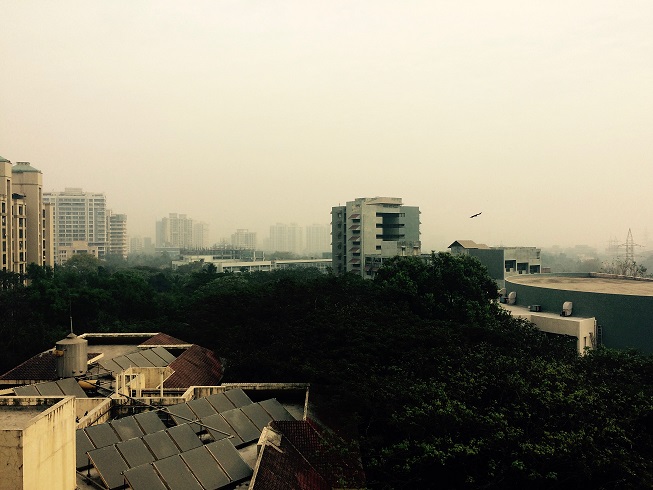
If you ever find yourself waking up on the seventh floor of the Tata Institute in Mumbai, this is what you should expect to see. Today’s weather forecast, ‘hazy’. Tomorrow’s — ‘cloudy’. After that, ‘smoky’. You get the picture.
Down on the ground, the situation is no better. Traffic controllers arm themselves with black face masks. Congested roads fade into a hazy mist. As Mumbai’s smog levels creep higher and higher, the question of how to reduce dirty emissions from vehicles is becoming increasingly difficult to ignore, for citizens and government alike.
Earlier this week, the Maharashtra government revealed its plans to address the issue of pollution — through a comprehensive electric vehicle plan. The Cabinet has cleared a new policy that encourages the manufacture and use of green vehicles through tax rebates for electric car buyers, financial incentives for manufacturing companies, and subsidies for new charging stations. Owners of electric vehicles will be exempt from road tax and registration fees, and offered a subsidy of up to 100,000 rupees. The government claims that the new policy will create 100,000 new jobs within the state. For greenies and climate activists alike, this sounds like a dream come true, right?
There is no doubt that electric cars are a useful strategy for reducing vehicular emissions. If every car and bike in India were replaced with an electrical equivalent, the transformation would be unprecedented. Smog could be a thing of the past. In India’s goal to go completely electric by 2030, it’s a bold step.
But I can’t help but wonder — of all the bold government steps that India is in need of it, is this the right one? Electric vehicles look good on paper. But looking out this window, it’s hard to agree this policy is adequate. At best, it’s a signal of the government’s decision to prioritise environmental action. At worst, it’s yet another example of government policy that perpetuates inequality in India. What sense does it makes to subsidise electric cars, if the roads they’re driving on are riddled with pot holes and lined with slums? Why should 100,000 people get cheap Teslas when millions of others are still vying for plumbing?
Last week, I would have jumped at any proposal designed to promote electric cars. They’re clean, they’re efficient, (most importantly) they look cool. But after a few days of walking the streets of Mumbai, I’m struggling to summon any enthusiasm for a policy that seems to disregard the needs of so many millions of Indian citizens, to whom electric cars are a distant dream. There is no question that improving air quality and reducing emissions should be a government priority. But the introduction of electric vehicles won’t stop the huge amount of biomass burnt by slum-dwellers, nor will it reduce the enormous emissions from India’s coal and oil power plants. Electric cars are a fantastic tool for clean energy — provided they come hand in hand with energy policy that meets the needs of Indian society beyond the richest 10%.
Reading about India’s environmental policy back home, I never considered it in relation to the growing divide between India’s have and have-nots. But being here now, it’s clear that any steps taken by the Indian government to address pollution must be taken as part of a larger mission — to reduce India’s crippling inequality. At its heart, getting rid of smog isn’t about reducing carbon footprints, meeting climate action goals or creating a cleaner planet. It’s about improving quality of life for the citizens of India. Looking out at the streets of Mumbai, it’s pretty clear that the citizens of this country are in need of a lot more than a few cheap Teslas. Electric vehicles will undoubtedly play a significant role in reducing vehicular emissions sometime in the future. But right now, let’s not forget whose future we are talking about when we speak of a clean future for all of India.
Not the Gateway to India I had envisaged
By Alexander Vaughan
Arriving in Mumbai I was truly surprised. I had heard that Mumbai was a lively, cosmopolitan city, with disorganised traffic, Bollywood and ever-growing wealth disparities. But on exiting the bustling Chhatrapati Shivaji Terminus (CST) in the Fort district, I was surrounded by Victorian gothic architecture. I found it hard to believe I was in India and not wandering around Europe. I have a basic understanding of Indian history, and have read of the influence of the East India Company and the British Raj, but I did not expect to see the colonial influence in such an overt form.
Near to CST are the hustling markets which I had anticipated, with locals exchanging rupees for cheap and delicious pav bhaji, onion pakora, samosas, masala chai and a widespread selection of local fruits and vegetables. Around me buildings are crumbling, streets are chaotic and rubbish piles up. Temples, mosques and various national monuments rise tall. The call to prayer from the local mosque is a low hum. Vibrant Hindu and Islamic dress are in abundance.
But it is the influence of the British which really takes me aback. Having travelled briefly in the South of India I find the British influence in Mumbai stark by comparison. The architecture, the language, government and educational system, the transport infrastructure and cricket are all on display and tell the story of colonialism.
But India is not simply a cricketing nation and a democracy based on the British system undergoing rapid development. The Republic of India has only existed for 70 years and is a federation of States with different languages, customs and ways of life which lay within boundaries drawn up at Independence. Behind the visual façade I encountered when I exited CST lays a culture with deep rooted systems and customs, which have existed on the sub-continent for thousands of years.
In our classes so far we have been introduced to the intertwined structures of caste, class and religion and the role they play shaping Indian society. Progress is complicated. Women have less opportunities and face structural hardships. Adding to the intricacies of Indian culture and its many sub-cultures, is the sheer scale of India – how to manage 1.3 billion people?
I need to remember that India has a dynamic and contested history, and that the learning we are receiving inside and outside the class is embedded in this history. I expect the field school will peel away a few of the layers, make things clearer, and organise a few pieces in the greater puzzle that is India. There is so much to learn and consider. I am excited and everyone in the group is engaged.
Political Economy and geography students start Indian field school

On Monday, 17 students majoring in political economy and geography arrived in Mumbai for a three week intensive field school experience. The field school is run by the Department of Political Economy and Geography in collaboration with three Indian universities/research institutions: the Tata Institute of Social Sciences (TISS), the Indian Institute for Health Management Research (IIHMR), and the Central University of Karnataka. The field school involves an intensive, integrated three-week program of classes and field visits addressing the political economy of development and environmental management in modern India. Students are engaged by Indian scholars and civil society groups working on issues of geo-political, economic and environmental importance and gain firsthand insight into the daunting challenges facing one of the most important nations in the contemporary global economy.
The first week of the program will be run at the TISS campus in Mumbai. Students will stay on campus at the Tata Institute of Social Sciences and participate in tailored classes and city field visits developed by the local academic staff, in close collaboration the University of Sydney convenors. This component of the field school will address India’s ‘national story’ of development, and raise questions about the contested process of economic development, environmental sustainability and social inequality.
In the second week of the program, students fly up to Jaipur in Rajasthan. Here they will stay with our partner organisation, the Indian Institute for Health Management Research. The IIHMR has specialist expertise in the delivery of social programs to poor and remote rural parts of India. This week’s program will provide an opportunity to see rural India firsthand and will include day trips to local villages and national parks where ystudents will begin to develop a critical appreciation of the contested relationship between economic development, human security and ecological sustainability.
The third week of the program takes us to Hyderabad where students will drive a few hours out to the Central University of Karnataka, in the regional city of Gulbarga. In this part of Northern Karnataka students will be exposed to some of the most pressing issues facing Tribal communities in India, and their efforts for political and economic security within a rapidly modernizing global economy.
The blog posts that follow will capture the student experience of contextualized learning and their reflections.
Geography and Political Economy students head to India again
In February 2018 Sydney University Geography and Political Economy students will again head to India for an intensive field school experience where they will study, observe and debate ‘The Political Economy of Development and Environment in India’.
This interdisciplinary cross-Faculty Unit of Study will be undertaken in partnership with our Indian partners the Tata Institute of Social Sciences (TISS), the Indian Institute for Health Management Research (IIHMR), and the Central University of Karnataka.
Daily blog posts will highlight research, field trip and other observations by participating students.
IT and Inequality
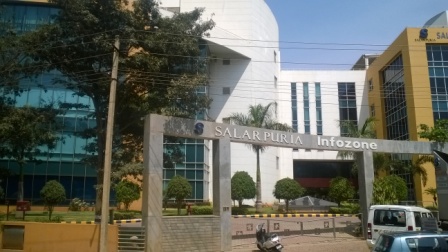
By Dan McGrath (B.P.E.S.S)
Our morning conversation was dominated by issues of food security, the Targeted Public Distribution Scheme (TPDS), poverty lines, basic freedoms and natural law, the merits of cash transfers versus ration books, the ethics of conditionality, and a wide range of other topics each considered from the point of view of Sen’s capabilities approach, feminist theory and neoclassical economic theory. We then moved out in Bangalore City.
Piling into yet another bus we undertook a day tour of Bangalore. Full circumnavigation of the city allowed us to pass through Electronic City. This oasis of modernity and its manicured structure was a stunning contrast to both the rest of Bangalore and, to an even greater extent, the grimier hustle and bustle of Mumbai. Here the garish logos of McDonalds, KFC and Pizza Hut — all displayed in English — dominated the landscape, signaling a patch of ‘development’ neo-colonially transplanted into peri-urban Bangalore.
The status of the many IT estates and campuses are similar to Special Economic Zones (SEZs where regular rules do not apply. Reduced corporate tax rates, loosened labour laws and purpose-built infrastructure are all aimed at incentivising the Foreign Direct Investment (FDI) that cities, states and nations so desperately crave. The question is, at what cost? And the answer is, inequality. Driving along yet another quintessentially Indian flyover, the juxtaposition was stark. To my left were marvels of modern architecture — sharp, angular lines dominated by glass and steel. To my right, formulaic concrete apartment blocks, the paint peeling and windows opaque with grime.
The heavily ‘development’ inspired growth has resulted in the creation of a Western-style middle class within Bangalore, driven and sustained by consumerism where the fruits of growth are poorly distributed, both in socioeconomic and geographic terms. As we spent the evening in a major tourist district, with street-sellers and beggars set against the colourful marketing banners of international brands, the inequities of Bangalore’s IT-led rise were clear.
Jai Ho!
By Stewart Just, BSc/BA
Today we attended a seminar on “Climate Change and Food Security: The Global and Indian Contexts” at the Institute for Social and Economic Change, Bengaluru. Our own Professor Bill (as he is called by almost all the academics we have met in India) laid out the broad picture of the interaction between climate change and food security. Other presentations, from scholars across India, covered the micro and macro issues related to climate change and food security. The overall message of the conference was that climate change will have several impacts on food security, primarily through ongoing urbanisation and changes in crop yields, but also on account of other changes such as the rise of supermarkets and fast food.
I was particularly interested by the presentation by Dr John Duncan from the University of Southampton. Dr Duncan spoke about his work in Odisha on natural disasters and resilience in regard to food security. According to his study the rice farmers affected by the 1999 cyclone in the region are in a state of ‘coping’ as rice farming is not remunerative and therefore does not provide a basis for the accumulation of assets. Because of this, the resilience of these rice farmers to climate stresses is in doubt. Other issues to be effected by climate change include agricultural development, policy and targeting of the ration system. What I heard made me reflect on our time in the Sacred Groves and the villages around Tuljapur. With the rise of extreme weather, I hope that these people and the governments of India will be able to uphold their situations.
The conference ended with a dinner and some dancing to the hit song ‘Jai Ho’. It was a great chance for us all to enjoy some relaxation together as our journey nears its end. We’ve had a bus breakdown, a plethora of miscommunications and several cases of ‘Delhi Belly’, but the group as a whole has done well to embrace these less planned parts of our adventure. The Indian people have been overly welcoming and accommodating and their energy has been infectious. I expect this Indian field school will thrive in the coming years as word spreads throughout the student body about the opportunity.
History and the British in Mysore
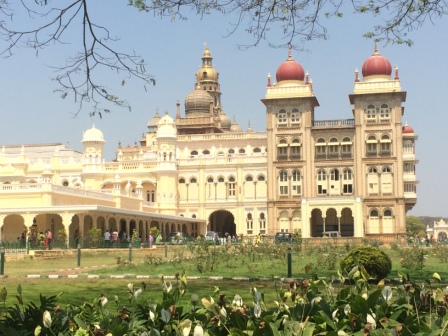
By Charlotte Askew: Bachelor of Education / Bachelor of Arts
Today we made the long journey from the amazing Madikeri to bustling Bengaluru. After nine hours of travel, we were warmly welcomed to the Institute for Social and Economic Change (ISEC), Bangalore. It is an All India Institute for Interdisciplinary Research and Training in the Social Sciences, established in 1972. Together with the University of Sydney, ISEC is hosting an International Seminar on Climate Change and Food Security, which we will participate in tomorrow.
To break up the long trip we stopped half way in Mysore and visited the Mysore Palace. Mysore Palace is among the grandest of India’s royal buildings and the second most popular tourist destination after the Taj Mahal. It was home to the Wodeyar family that ruled the Kingdom of Mysore from 1399 to 1947. The Wodeyars were the only Indian Royal family to have ruled a kingdom for more than 500 years. The Palace is symbolic of the present and the past – the government and hierarchy of the pre-colonial period and the strong influence of British culture that remains a defining feature of present day India.
The Kingdom of Mysore in southern India was founded in 1399. The vast majority of the people lived in villages and agriculture was their main occupation. Towards the end of the 18th century, there was a series of wars fought between the Kingdom of Mysore and the British East India Company. The agricultural economy changed under the British, when tax payments had to be made in cash and were used for the maintenance of the army, police and other civil and public establishments. A portion of this tax was also sent to England. England and the Maharaja of Mysore came to an agreement and implemented the British rule in Mysore. The influence of the British is obvious throughout India and particularly in Mysore.
English architect Henry Irwin built the palace in 1912, after the previous palace was destroyed in a fire in 1897. The Palace includes English, Hindu, Muslims and Indian architectural motifs. Over the past two and a half weeks we have all noticed the British influence still present in India. Tea is always served to us more than once a day; we have witnessed many cricket games on the side of the road as well as cricket always being a topic of conversation with us Australians. In Mumbai, we visited the Gateway of India, which was built to commemorate the visit of King George and Queen Mary in 1911. The architecture of the gateway and the surrounding buildings and hotels are all of gothic style. Many of the students we have spoken to have a desire to study in Britain, as they believe a degree from an international university is worth more.
It was very interesting for us to visit the Mysore Palace as it was a complete contrast to other places we have visited on the field school, in particular in Dharavi, the slum in Mumbai. The palace was so extravagant and underscored the income divide in India where the wealthy are extremely wealthy and the poor are awfully poor. But there is a growing middle class that is increasingly educated and globalised. The growing IT sector in Bengaluru is home to an emergent middle class and presents a stark contrast to the poverty and agricultural dependent societies we have seen elsewhere in India.
Dear oh Deer!
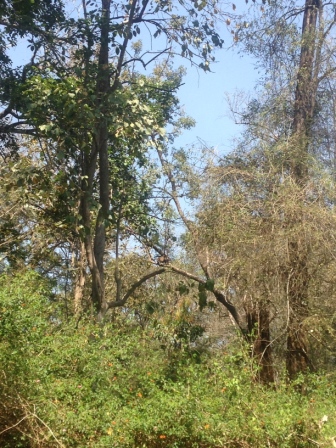
By Tessa Harris – Bachelor of Science, Bachelor of Arts
Today’s breakfast was filled with excitement and anticipation for the day ahead at the Nagarahole Tiger Reserve. Named after the tributary stream, ‘Nagarahole’, the national park covers over 642km2 and crosses regions in the Kodagu and Mysore district. In the 19th century, the region was a timber plantation, but in 1975 was declared a national park.
After a three-hour bus drive we arrived with and within two minutes, spied a small group of Spotted Deer. We travelled further into the park arriving at the rangers’ houses and offices. In a mad rush, we were immediately whisked back onto the bus as there had been a sighting of two leopards nearby. During the current mating season, males and females hunt alone but in proximity to one another. In two separate trees, one female leopard and one male were lying down on long horizontal branches observing us as we watched them, cameras in hand.
Back at the park offices, Mr Bellippa gave us a presentation on the threats and management techniques of Nagarahole Tiger Reserve. Three of the main problems are: fires, human-animal conflict and the tribal population. Being one of the driest regions in the country major fires occur every 45 years causing significant and sometimes permanent damage. Fires usually occur between March and April and the park employs 280 staff to manage fire watchtowers. There are also 600 field staff with radios who can raise a fire alert within an hour so it can be contained. Fire lines are also prominent in the park.
Human-animal conflict is being quite well managed in Nagarahole. There are 130 villages bordering the park and while elephants in particular cause significant damage to coffee plantations, there are a number of management techniques working to ameliorate the problem. Education and employment strategies amongst the local villagers help to protect the wildlife. Other strategies such as elephant trenches and new railway fences have been built in an effort to keep the elephants from wandering in to local farms. Many of us thought poaching would be one of the main difficulties rangers face, but since 2012, there have been zero accounts of poaching in the area. This has been maintained through effective patrolling on foot and in vehicles combined with the threat of intruders being shot on the spot!
The issue of tribal villages located inside the park’s boundary is very sensitive. The government has introduced a system of voluntary tribal relocation and rehabilitation in which families are given two options. Families who opt for voluntary relocation are offered either a cash sum or three acres of land with a monthly allowance where families fall below the official poverty line. Sometimes the choice to move is not voluntary. In recent times 1200 families that still live in the park are facing increased pressure to accept the relocation packages.
Over the day we saw all kinds of animals – elephant families, bison, wild dogs, monkeys and different species of deer.
To top off a wonderful day spent in Nagarahole Reserve, our bus journey back to Madikeri took a surprising turn when the gear box decided to give way. Taking it all in our stride we found a local mechanic and stopped for some chai on the side of the road anxiously awaiting the verdict. Within 30 minutes we were back on the bus and travelling up the winding roads surrounded by beautiful vistas of Madikeri.
Conservation & Development Dilemmas
By Sydney Colussi – B. Political, Economic, and Social Sciences
The Cauvery River extends approximately 400 kilometres through Karnataka to Tamil Nadu and Andhra Pradesh. It supports the livelihoods of millions of people. Today, we visited the sacred start of the river in the Kodagu region of Karnataka. Following the removal of shoes and changing into appropriate dress – cloth skirts for those of us with ankles showing – we slowly made our way towards the river’s edge. Walking up the stairs, the hazy, mountainous backdrop of the Western Ghats served as a reminder of the sanctified nature of the surrounding environment.
This region is fundamentally important for religious, cultural, and environmental reasons. At the river-side temple, we gained some insight into the area’s spiritual character. Standing in line, I noticed that the river looked more like a pool, with steps leading down to the water’s edge. Individuals and families dressed in brightly coloured, formal clothing were either dipping their hands and feet into the water or fully immersing themselves. While our group opted for partial rather than full immersion (i.e. hands and feet), the experience still strongly re-affirmed the symbolic importance of the river.
Next to the sacred pool – which, I later discovered, is filled by a natural underground spring – we waited with other visitors to receive blessed holy water. Afterwards, we made our way towards additional religious altars within the sacred site. As first-time visitors, it was fascinating to witness the spiritual and cultural meaning assigned to both the river-pool and its surrounding environment. While the river is responsible for physically sustaining millions of lives, this particular area also serves an important symbolic purpose – it embodies spiritual and emotional ties to the land.
We encountered a similar appreciation and respect for the environment at Talacauvery wildlife sanctuary. Walking into the park, we passed a sign advertising the conservational benefits of the sanctuary’s trees – production of oxygen, soil and water conservation, etc. – and concluding with ‘so grow more trees’. As we navigated the grassy terrain, it was clear that a considerable amount of time and energy had been dedicated to preserving the unspoiled landscape. The lush trees, well-maintained ponds, and clear blue skies mirrored local conservation efforts. This sanctuary reflects the local forestry office’s key priorities, including the conservation of land and wildlife, mitigation of human-animal conflict, and maintaining biodiversity.
In India, the status of environmental protection is highest in national parks. As a result, wildlife reserves such as Talacauvery play an important role in national conservation efforts including preserving wildlife on the brink of extinction, such as rhinos and tigers. The park’s capacity to protect India’s endangered flora and fauna is necessary to sustain the Western Ghats’ high eco-fragility. These conservation efforts, while important in preserving the Ghats’ reputation as a ‘hotspot of biodiversity’, inevitably provoke tension between human society and animal habitat.
The day concluded with a student seminar on coffee, agroforestry and sustainability. Group discussion focused on both the compatibilities and complications embedded in the relationship between economic development and sustainable conservation efforts. In other words, how do you decide which land is dedicated to elephants or agriculture? There are so many stake-holders in negotiations over land use and interests vary between the state, NGOs, corporations, farmers, consumers, local and tribal communities with spiritual sentiments attached to the land, as well as the wildlife.
The Cauvery River and Talacauvery Sanctuary are both good examples of the conservation dilemmas facing India at this stage of its development.
The Sacred Groves of Madikeri
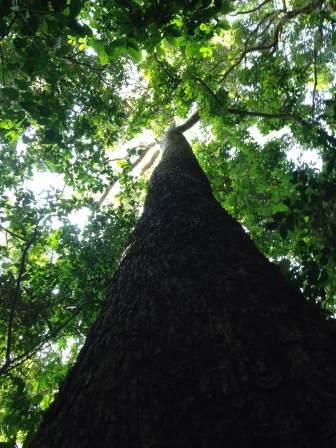
By Kynan Allatt-Churm
Our first morning in Madikeri in the Western Ghats! After a traditional breakfast of ‘idly vada’, as well as eggs and toast, we headed off to the forestry office. This was an invaluable experience as it provided a lot of context to a region we knew very little about. Most rainforest areas are delicate ecosystems that are vulnerable to change. In Madikeri, we were told that negative changes to the Western Ghats would affect the wider Kanataka region, particularly water pollution. The Western Ghats acts a type of water tower to the southern peninsula of India, supplying water to around 250 million people. The vulnerability of this green area has been recognised by global organisations such as UNESCO, which has placed it on the World Heritage List, with 39 Heritage sites inside it. One major reason for this is that the region is home to 325 threatened species.
The Chief Officer of Forestry for the Western Ghats, Mr Manodge, taught us about the balance between conservation and sustainable livelihoods in this region. One main issue he said the region faced was conflict between animals and humans. This was mainly due to animals such as elephants straying onto agriculture lands and either injuring or killing workers, getting electrocuted by boundary fences, or being shot by farmers. Surprisingly, we learned that multi-national corporations who have invested in the region have worked productively with the Forest Department on conservation issues.
After lunch, which included locally produced coffee, we headed to a nearby sacred grove – there are 1,214 of these groves in the Kodagu region. These sacred groves are managed by the tribes that have a spiritual connection to them. Under a decentralised management plan, only the recognised tribal group can enter these forests. Anyone else must get formal permission. Tribal management of the land protects the sacred role of these forests. Unfortunately the law doesn’t deter everyone and poachers are a series problem facing the area – especially in regard to the removal of wildlife and fruits.
It was interesting to compare this decentralised self-governance approach to Australia’s top down approach to nature conservation and indigenous land rights. It made me wonder if such a decentralised form of land management could be used in Australia? The issues here in Madikeri are complex. But it seems to me that a decentralised method of forest management has allowed the region to find a balance between land conservation and sustainable agricultural livelihoods. It is a unique approach, but effective.
As we walked through the sacred grove in the afternoon, our guide pointed to certain trees that he said would fall over in the next 10 years due to disease and then would be removed from the forest. This knowledge that had been passed down through generations seemed to validate this traditional community-based conservation, in that the people who have been entrusted to protect it have the greatest understanding of it.

